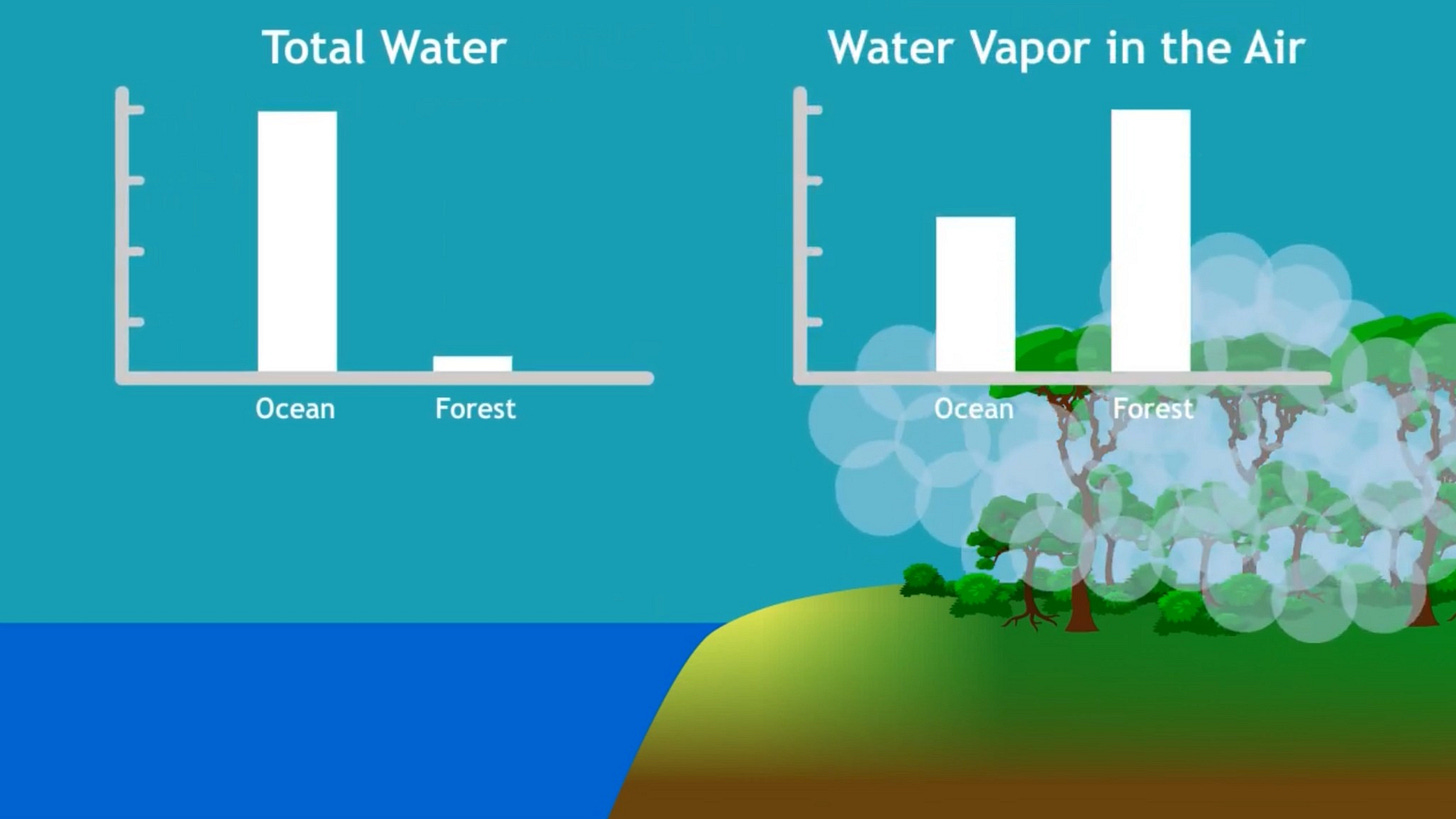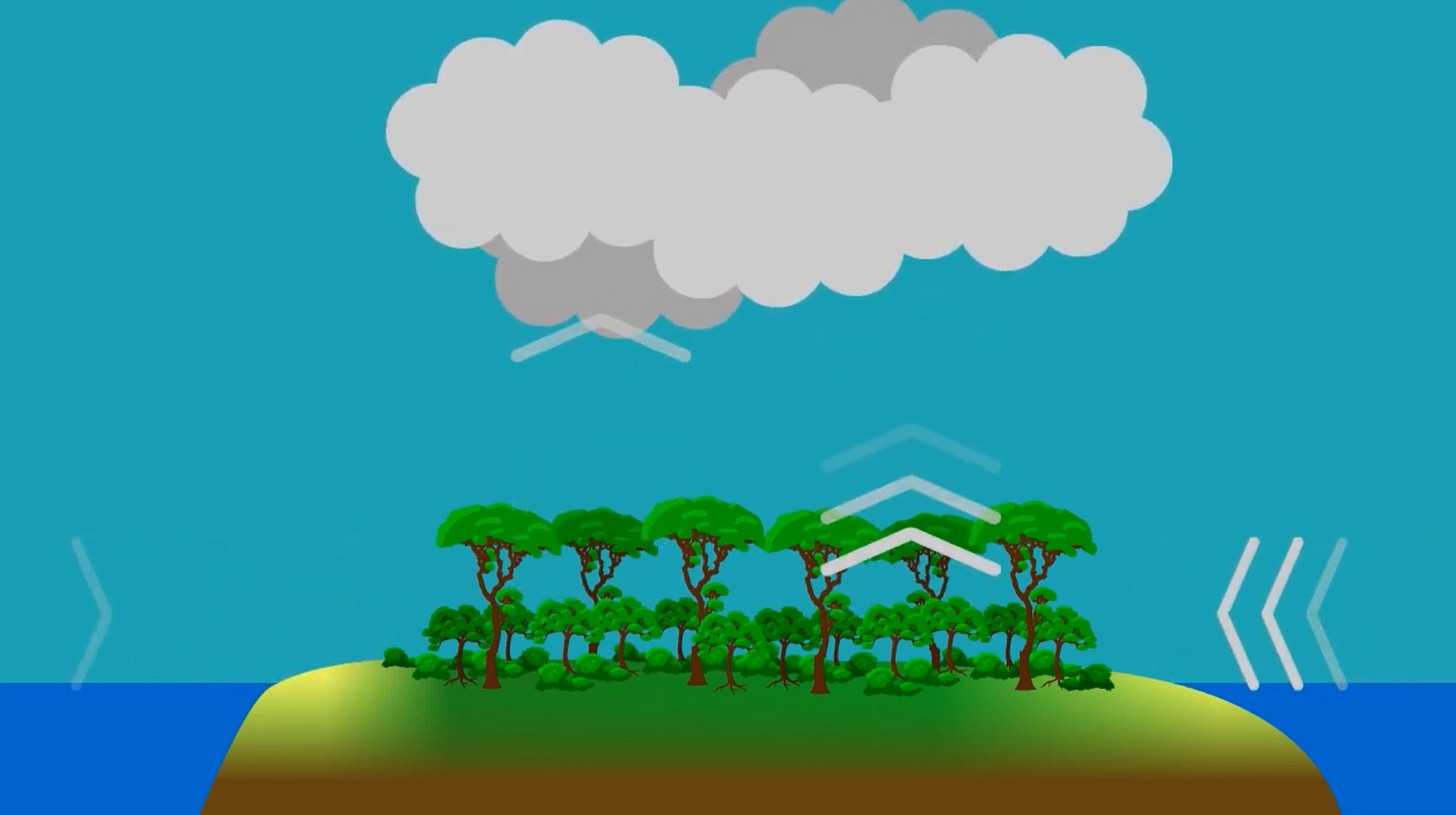Rain-making role of trees, rainforests coming to fore
‘Biotic pump’ theorizes how forests generate rain, even winds

Trees help generate rain. Especially rainforest trees. That’s what the science of the past half a century informs us.
Based on experiments and observations starting in the 1970s, ecologists have shown that trees replenish local precipitation by evaporating water through their leaves, a process known as transpiration.
Ecologists estimate about half the rainfall landing in the forest has been recycled by the forests themselves, as indicated in a 2024 Nature paper.
A theory proposed by Anastassia Makarieva and the late Victor Gorshkov takes this a step further by suggesting even the rainfall that wasn’t recycled likely was heavily influenced by forests.
The 2007 scientific article Makarieva wrote with Gorshkov and follow ups in 2009 and 2010 provide more details for scientists, while this post and others on her Substack publication, Biotic Pump and Biotic Regulation, provides more reader-friendly background.
Below, I interpret the theory in a simplified form with background for non-scientists. Soon, I plan to come back to these concepts in the context of Amazon “tipping point” projections.
Air flow becomes wind
Under the “biotic pump” theory, transpiring trees create conditions that actually help generate winds. These winds pull moisture toward the forests and carry it further inland.
A hot surface can generate winds, as I learned while working on an agricultural experiment in Arizona. On hot days, it would be stifling for much of the morning. Somewhere around noon, the almost unbearably hot surface of the desert field would cause air to rise—thus creating a vacuum to pull in more air to fill the void.
To us, it was a welcome breeze.
The biotic pump theory uses a similar concept for generating winds, but not with the warm surface as the deciding factor. In this complex theory generally welcomed by life scientists but controversial among meteorologists, it’s the moisture from the forest itself that helps create the vacuum pull of low pressure, causing air to shift in a way that generates winds.
Rainfall 101
Before delving into the biotic pump, let’s take a step back to some basic concepts on how rainclouds form and precipitate in the atmosphere.
Hot air rises. We all know this concept from hot air balloons. In fact, air tends to move in “parcels” of various sizes and shapes. Individual parcels, minus the colorful balloon wrapper, interact with their surroundings to move up if they are hotter than surrounding air and drop down if they are cooler than surrounding air.
Hot air holds more moisture. That’s partly why evaporation rates speed up as temperatures rise.
The atmosphere cools down with height, at least in the portion closest to the surface where rainclouds form.
As clouds rise, they cool down, because air temperature cools with height.
Precipitation occurs if they reach temperatures too cool to sustain the amount of moisture they grabbed while in a hotter, more energetic state.
Forest complexity feeds pump
Under the forest canopy, temperature tends to remain relatively comfortable, compared to unforested areas. The surface of the canopy, on the other hand, runs closer to actual air temperatures—hotter during the day than the enclosed, shady area below, but still far cooler than bare soil.
Even so, clouds may get an extra boost from the higher “surface” of the canopy compared to bare soil. This may give the winds a head start on their ascent into the cooler atmosphere.
The biotic pump theory, however, focuses on the role of the clouds themselves in pulling in moisture, as well as the role of forests in providing them with moisture.
Forests have a complex structure that actually leads to having more water vapor over them than over oceans.
Image snipped from 5-minute video on the biotic pump created by Jim Eisenstein based on the 2009 and 2010 papers cited above.
A smooth ocean is basically a two-dimensional surface. In rough water, waves may create a 3-D experience for the interaction of water with the atmosphere. But even the waves sought by surfers don’t reach nearly as high as the canopy of an intact rainforest.
Compared to the one layer of a smooth ocean, tropical rainforests may have six layers, as measured by leaf area index. That’s the assessment of how many layers of leaves can exist over the same square foot of ground.
Some plants grow close to the ground, shrubs and young trees grow at various heights, and the crowning glory of the ancient trees create the uppermost canopy.
These extra layers give forests more surface area feeding water into the atmosphere.
Transpiring trees keep water flowing
Trees must transpire to survive. Lacking hearts to pump liquids around, trees use transpiration to move water through their systems.
When a droplet of liquid water at the leaf surface converts to airborne vapor, its evaporation creates a pull that allows another droplet of water to replace it. The resulting vacuum-like pull, in turn, lifts some water from the soil up through the roots.
As some of this transpired vapor rises above the canopy, it forms clouds that continue to rise. As they rise into colder air, the clouds become too saturated to hold all the water vapor they’ve collected. Some of the vaporized water converts back to liquid.
Just as evaporating water picks up some heat, the conversion from vapor back to liquid releases some heat. This extra heat contributes to lift the cloud further up, bumping up chances for more precipitation to occur in the cloud. This cycle increases the chances of water falling from the cloud as rain.
Image snipped from 5-minute video on the biotic pump created by Jim Eisenstein based on the 2009 and 2010 papers cited above.
Forests pull in moist air
From a biotic pump point of view, when water moves from the forest to the air or rains out of the cloud, it reduces local atmospheric pressure. This creates a bit of a vacuum, not unlike the dynamic that creates thermal winds over hot agricultural fields.
That, in turn, sucks in more moisture-laden air. Rinse and repeat.
When millions of trees in a continuous expanse of rainforest are transpiring, they keep the cycle going. They share water to boost cloud formation out of thin air, and provide additional water to existing clouds. Then, when the water vapor in the clouds precipitates into rainfall, the water comes back into the forest—typically somewhat downwind from where it started.
The beauty of this process is that it keeps replenishing moisture on and on—far beyond the usual 400 miles seen as the typical outer limit on how far moisture can travel inland.
In many ways, this is good news. It speaks to the stabilizing presence of forests. Not only do they recycle the rain, but they generate it in ways that come together naturally based on the way individual trees move water through their leaves. It’s a feature that looks coordinated, but in fact emerges naturally from the survival behavior of individual trees.
It also would help explain how forests did so well in the hotter climates of the past, when they expanded well beyond their current confines.
But there’s a big catch: It only works if those forests stay mostly “closed”—in effect, where there are vast expanses of forests with a canopy so full it sheds little light below. And it’s not only the size of the forest but also its location that matters. The process needs a nearby body of water to get rolling.
With humans in the picture this time around, that’s a big problem. Forests can’t make rain if they’ve been turned into construction material or cattle ranches.
And good science can’t easily guide forestry practices unless it’s widely accepted and incorporated into computer models.
Either Thursday or next week, I plan to come back to this concept in the context of potential tipping points for the Amazon. In the meantime, this 5-minute video animation does a good job of illustrating the biotic pump.
This 5-minute video on the biotic pump is worth watching. Jim Eisenstein created it based on the 2009 and 2010 papers cited above.
CORRECTION: An error in the first version of this perspective (in the fourth from last paragraph) used the word “shade” instead of “light” in this sentence: But there’s a big catch: It only works if those forests stay mostly “closed”—in effect, where there are vast expanses of forests with a canopy so full it sheds little light below.



